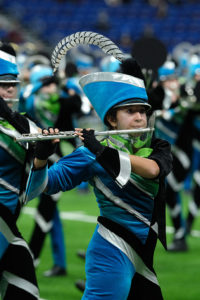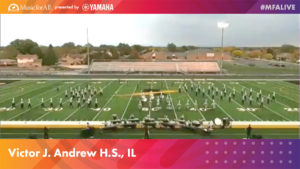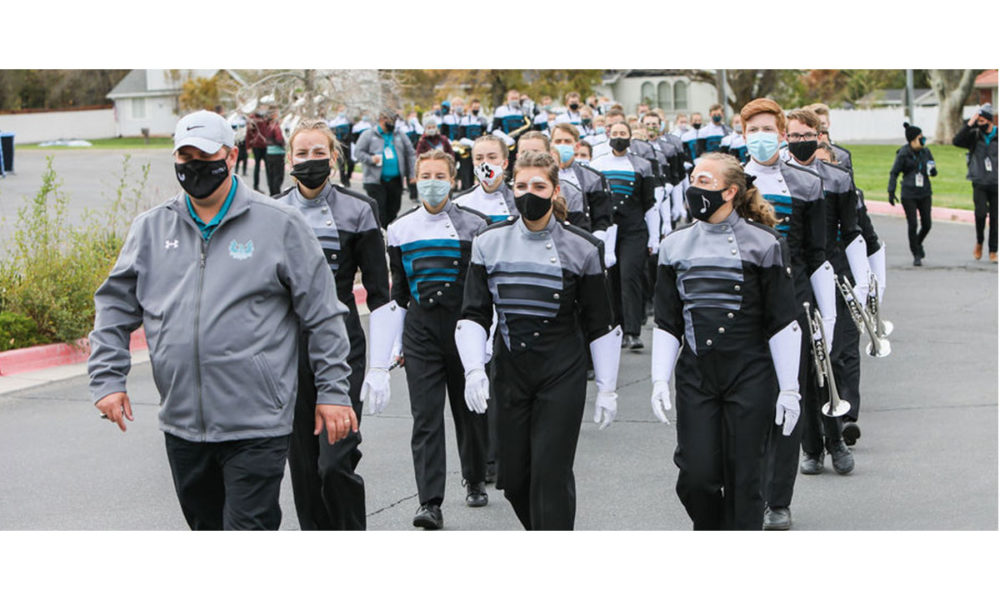With everyone focused on safety and community, Texas and Utah pulled off in-person high school marching competitions while most other band circuits turned to virtual events.
The Claudia Taylor Johnson marching band is celebrating its first Texas University Interscholastic League (UIL) 6A State Marching Band Championship. But the band’s ultimate victory—making it all the way through such a fragile 2020 season—took more dedication and sacrifice than ever before, according to Jarrett Lipman, director of bands.
“There was a risk in pursuing a season, but it also gave the kids a sense of renewed determination to overcome the challenges,” says Lipman, who was recently named one of Yamaha Corporation of America’s “40 Under 40” music educators in the country.
Balancing Safety and Normalcy
 Community sticks out as the driving force behind the efforts of competition circuits and band directors in the fall of 2020. Decisions about how the marching band season would look depended largely on regional health conditions and guidelines. With safety as the preeminent factor, many decisionmakers also prioritized normalcy. After months of virtual learning and isolation endured by students in the prior spring, educators and supporting organizations across the country worked tirelessly to give marching band participants some sense of the community-driven, music-filled fall that they would normally have.
Community sticks out as the driving force behind the efforts of competition circuits and band directors in the fall of 2020. Decisions about how the marching band season would look depended largely on regional health conditions and guidelines. With safety as the preeminent factor, many decisionmakers also prioritized normalcy. After months of virtual learning and isolation endured by students in the prior spring, educators and supporting organizations across the country worked tirelessly to give marching band participants some sense of the community-driven, music-filled fall that they would normally have.
After lengthy discussions with band directors across the state, the Utah Music Educators Association (UMEA) decided to move forward with in-person competitions. The organization left participation up to each individual band, and all but three groups decided to compete. “Our whole premise going into it was that if we’re going to have football, then we’re going to have marching band,” says John Miller, UMEA Marching Band Committee Chair.
The Texas UIL felt similarly. “We didn’t want, at the state level, to tell every school and every student across the state that they could not participate,” says Dr. Jamey Harrison, Texas UIL deputy director.
Those ideas drove students in the Thorndale (Texas) High School marching band, too. They hit obstacles like split schedules and COVID-19 cases early on. “We just had a hodgepodge of students to work with in the beginning,” says Michael Powers, director of bands. “They knew that other schools were meeting five days a week as normal, but they told me they would work harder, smarter.”
 On a national level, Music for All (MFA) waited as long as possible to cancel its Bands of America Grand National Championships but also knew that groups would have a limited ability to travel. Instead of its normal events, MFA streamed three live showcases open to any ensemble from drumlines to jazz bands. “We wanted to serve music programs where they were,” says Deborah Laferty Asbill, MFA’s vice president of marketing and communications.
On a national level, Music for All (MFA) waited as long as possible to cancel its Bands of America Grand National Championships but also knew that groups would have a limited ability to travel. Instead of its normal events, MFA streamed three live showcases open to any ensemble from drumlines to jazz bands. “We wanted to serve music programs where they were,” says Deborah Laferty Asbill, MFA’s vice president of marketing and communications.
Higher case numbers and more restrictions meant a virtual season looked most plausible in the northeast. As part of a renewed commitment to serving bands’ specific needs, USBands formed a focus group of 12 band directors early on to help plan the season. The directors’ feedback was telling, says Sean King, USBands executive director. “In one conference call, we asked everyone, ‘What’s going on in your school district?’” King recalls. “The first person said, ‘We’ve got seven minutes ready to go,’ and the absolute next person said, ‘We haven’t been able to pick up our instruments in three months.’ We knew at that point that we were going to have to be responsive to whatever was going on in the communities.”
Therefore, USBands built an eight-week virtual season that mirrored the rhythm of a normal competitive season. Every week, bands recorded performances at rehearsals or football games, sent their videos in, and received commentary. “We even did an awards ceremony, trying to make it as much of a real-feel as possible, even though you weren’t getting on a bus, going somewhere, or seeing other bands perform,” King says.
Tournament of Bands (TOB), also based in the northeast, chose a virtual season as well. It featured more than 100 performances during a 10-week period. A unique panel of judges each week gave groups feedback from many perspectives. They weren’t focused on competition, though. “Everything we did was based more on educational support and survival for band programs,” says Jeff Dent, TOB director.
Last spring, Cavalcade of Bands planned to move forward with live shows, but changes in the area’s health situation forced it to pivot. The organization offered two options to bands. Participating groups could either submit videos for commentary or have a live clinic through a partnership with West Chester University. Professors from the university led two-hour clinics personalized to each band’s needs or interests.
Changing Event Protocols
The states that allowed in-person marching events worked closely with health officials to create guidelines for students, supporters, and directors.
UMEA asked show hosts to consult with local health department officials, school districts, and administrations to make sure they followed all the necessary guidelines. Miller says that each event operated a little differently, but that most hosts limited show seating to 25 percent capacity. They also had strict schedules for participating bands that prevented them from watching the other participants, but a local television station broadcasted all the events live.
The guidelines seemed to work. Brek Mangelson, director of bands at Farmington (Utah) High School, says that simply following protocols kept the band performing. The band was thankful not to have any student-to-student COVID-19 transmissions and didn’t miss a show, he says. Farmington completed the season as 5A Utah state champion.
“The students sacrificed a lot to stay healthy, so being able to compete and have the success they did meant everything to them,” Mangelson says.
Effective, detailed communication between UMEA, directors, and parents led to the effectiveness of the season’s protocols. “I’m shocked to even say this, but we never got a single complaint,” Miller says. “I just think everybody knew that this was going to be a different year and that they had to have patience with this. They were just excited to be having marching band.”
The Texas UIL collaborated with several agencies and its own medical advisory committee to create extensive guidelines for its bands and events. The organization capped stadium capacities at 50 percent, required everyone older than 10 to wear a mask, and suggested online programs and tickets to limit contact.
Virtual events operated with safety in mind, too. USBands broke down divisions based on the number of participating students rather than school size. Judges took local regulations into account. Connecticut, for example, required a 12-foot space between students while most other states only required 6 feet of distancing. King says judges had to focus on what they were seeing rather than what they wanted to see.
Dealing with Financial Ramifications
Band programs and marching organizations also adapted their seasons to limited funding. Most organizations focused on creating educational value rather than financially lucrative events. “We tried to create a program that would at least break even, so that we could afford to give our adjudicators something for their time and still make it affordable for the bands,” Dent says.
Virtual programs were able to operate with relatively low budgets without venue and travel expenses. Referring to USBands’ decisions about creating an affordable, virtual season, King says, “It wasn’t going to do much more than keep the lights on, but it was a mission-driven decision.”
To participate in Cavalcade of Bands programming, bands had to pay their yearly membership fees. To help offset those costs, Cavalcade of Bands provided a free virtual adjudication for each band and paid half of the cost for each live clinic.
Without major events and ticket sales, MFA did have to furlough staff. It reduced expenses and relied on donor support to stay afloat while trying to keep entry fees for its showcases modest. “There really was a community that pulled together to make sure we moved forward,” Asbill says.
On the other hand, the canceled season opened up new educational avenues. “[Music for All] had to look at new ways to serve music educators and students that we normally wouldn’t have the time to develop,” Asbill says.
MFA held several webinar series that focused on topics like career-related guidance for young music educators and teaching social-emotional learning through music. The organization hopes to continue these educational endeavors beyond the pandemic, Asbill says.
MFA is also optimistic for next year. More than 260 bands have already registered for the 2021 season, Asbill says.
With its virtual fall marching season being so well-received, USBands has created a virtual season for concert and jazz bands this winter. Marching groups can participate as well.
The Tournament of Bands enjoyed the chance to support bands in a new way, Dent says. “We didn’t focus on what we needed to get more points; we focused on how students could perform better,” he says.
Surprisingly, UMEA found a ticketing system that it might continue because of its success, Miller says. To limit crowd sizes and allow time to sanitize, show hosts sold tickets in blocks of four or five bands based on their classifications. “Every show made more profit this year than it ever had,” Miller says.
For some bands, these opportunities didn’t just give students something to work toward. The activities kept their programs afloat. “One of the most gratifying things that came out of this was an email from a band director that said, ‘Thank you for putting this together because without this, we wouldn’t have marching band this year,’” King says.
Celebrating Success
The champion bands all emphasize student buy-in as a crucial factor in getting through the season. Lipman says his students committed to the phrase, “Stay positive, test negative,” to keep the season moving forward. He says students made sacrifices outside band, like avoiding gatherings and limiting exposure to keep their friends healthy.
The season’s challenges seemed to make its end even more meaningful. “With so much sadness in the world, the season gave them something positive to get up for everyday and look forward to,” Lipman says. “We said from day one, the victory of the season was making it to the end with everyone healthy and celebrating together.”
Powers, who contracted COVID-19 himself, says his students’ steadfast dedication actually made the year more fulfilling than any other. “These kids just kept working,” he says, adding that section leaders stepped up to performance preparations. The students’ commitment led Thorndale to a 2A Texas UIL state championship.
Powers says that walking off the field at the Alamodome filled him with emotion. “It all hit me—how hard they worked to get here, how many obstacles they had to overcome,” he says. “All of these things, and they were still able to make it to this moment.”
Claudia Taylor Johnson’s band experienced similar feelings. “We felt an incredible sense of accomplishment and relief walking out of the tunnel,” Lipman says.
For those that persevered, marching band filled an even bigger role in students’ lives than normal. “Students have faced isolation and uncertainty in ways they’ve never faced in their lives, so to have the opportunity to be with their cohorts in the marching band and work together to achieve a common goal really provided some additional benefits this year,” Harrison says.


